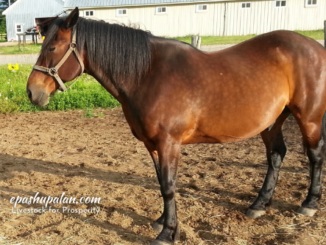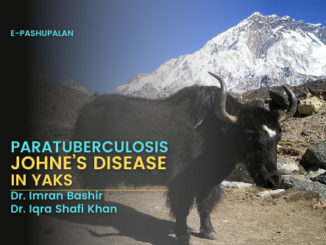It is most frequently encountered problem in equines and multifactorial in origin. Clinically, disease is characterized by varying degree of signs of abdominal pain, and dehydration-electrolyte balance. On the basis of different factors involved in its causation colic can be classified into four types:
1. Spasmodic colic
It arises because of severe contraction of intestine. It occurs when horse if provided with cold water in hot weather conditions.
Clinical picture: In this horse will shows signs of iintermittent pain, rapid course (short duration) and favorable prognosis. Episodes of colic of 5-15minutes are usually seen. Because of severe straining and contraction slight increase in body temperature is recorded. Laboured breathing, congested mucous membrane, rapid pulse, sweating and increase intestinal sounds are common clinical findings. Defecation takes place at short intervals and the feces may be semi-solid or fluid in character.
Line of treatment: Atropine sulphate as spasmolytic drug alongwith flunixin meglumine as pain killer should be given.
2. Flatulent colic
It results due to excessive gas formation in the digestive tract. It leads to the excessive distension of the bowel with gases particularly the caecum and colon. It results due to feeding of berseem or mouldy feed
Clinical picture: In this type of colic sudden continous pain is present. There will be abdominal distension specially seen from right flank area. Tympanic sound can be easily auscultated. Increased respiration, presence of colic signs and no passage of faeces are prominient signs.
Line of treatment: giving laxatives (Liquid paraffin) and carminative drugs alongwith fluid therapy will resolve the problem.Intestinal tympany can be relieved from caecum by trocarisation through the right and left flanks.
3. Impactive colic
It results due to gas formation in the digestive tract. Defective teeth or obstruction by large faecolith or heavy parasitic load or large amount of mud or sand can lead to this condition.
Clinical picture: continous pain with restlessness and typical signs of colic are seen. Straining during urination and defecation is seen with no faecal output. In subacute cases condition starts slowly and horse usually show abdominal discomfort signs. Intestinal sound are absent or much decreased in intensity. Decrease in pulse will be seen and no intestinal sound can be auscultated. Rectal palpation will reveal caecal impaction.
Line of treatment includes: passage of nasogastric tube and infusion of laxatives alonwith with fluid therapy and pain killer is advisable. Anthelmintic drugs is also recommended to reduce the parasitic load.
4. Obstructive colic
It results due to intestinal accidents. Intestinal torsion, strangulation and intussusceptions. Intestinal torsion (Volvulus) is due to the rotation of sigment of the intestine around its mesenteric axis. Sometimes it is partial or sometimes it is complete. Intestinal strangulation seen in condition where occlusion of the intestinal lumen by pressure from outside. Invagination (Intussusception) seen due to telescoping of a section of the bowel into a portion immediately behind it, it is especially in ileo-caecal junction.
Clinical picture: There will be signs of colic with absence of defecation with very weak peristaltic movements.
Line of Treatment: Surgery is the only line of treatment for effectiove recovery. Pain killer with sedative in cases of severe pain is advisable before the surgery starts
Differential diagnosis of different types of colic on the basis of clinical signs
- Assessment of Pain: General signs of pain are rolling, pawing, lying down, kicking at abdomen, looking at flank, sweating, crouching. Intense pain is seen in proximal obstruction and severe enteritis, moderate pain is seen Non strangulating lesions, mild pain is seen in small colon impaction and intermittent pain: Spasmodic colic
- Fever is seen in either anterior enteritis and peritonitis leading to colic
- Gut sounds: Decreased gut sounds indicates peritonitis or paralytic ileus whereas increased gut sounds indicates Spasmodic colic
- Nasogastric intubation: It is for diagnostic and therapeutic use. Huge gastric reflux is seen in anterior enteritis.
- Peritoneal fluid analysis: Peritoneal Fluid is altered in intestinal strangulation and bowel necrosis. Higher protein content and increased TLC value suggests peritonitis.
Pulse rate as prognostic marker in colic. In case of simple lesions 40-65 bp, in severe lesion-65-80 bpm and in poor prognosis it will be above 100 bpm
Immediate management of colic in horse
- Control of pain (analgesia) : First and foremost approach in treatment should be controlling the pain. Analgesia must be administered after clinical evaluation since these may mask the signs of progression of the cause of colic
- Laxative/lubricant: Movement of impacted ingesta is achieved by combination of fluid therapy and administration of inert lubricating agents. 100-200 ml/kg of iv fluid are effective in softening many impacted masses. Mineral oil(liquid paraffin) act as surface lubricant which facilitates passage of ingesta through GIT(direct lubricant, reduces intestinal water absorption). Psyllium- acts by increasing water content and bulk of fecal matter. Effective for treating sand impaction
- Fluid therapy– Choice of fluid in horses is Ringer’s Lactate Solution. In obstructive case >100ml/kg of RL is used to increase gut motility that leads to movement of ingesta whereas in Infective cases 40-60ml/kg of RL is used.
|
The content of the articles are accurate and true to the best of the author’s knowledge. It is not meant to substitute for diagnosis, prognosis, treatment, prescription, or formal and individualized advice from a veterinary medical professional. Animals exhibiting signs and symptoms of distress should be seen by a veterinarian immediately. |






Be the first to comment